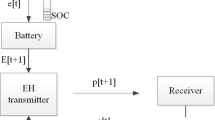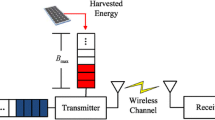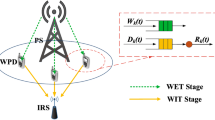Abstract
In Body Area Networks, for energy harvesting-powered, managing the renewable energy to provide delay-sensitive services is of significant importance. In this paper, we propose an online algorithm to allocate resources, i.e., energy and channel, to maximize the user utility while guaranteeing the worst-case delay. To this end, we first formulate a user utility optimization problem, characterizing the stochastic nature of energy harvesting and energy consumption. Furthermore, a priori knowledge of any this processes is not required. Using Lyapunov optimization techniques, we decompose the problem into four sub-problems, i.e., battery management, collecting rate control, transmission power allocation and dropping rate control. Low-complexity online resource allocation algorithm is proposed to address these problems for user utility maximization, while we further analyze the performance of the online algorithm, in terms of the upper bounds of queues, required battery capacity, and the optimality of the proposed algorithm. Simulation results verify our analysis and the efficacy of the proposed algorithm.










Similar content being viewed by others
References
Cao H, Leung V, Chow C, Chan H (2009) Enabling technologies for wireless body area networks: A survey and outlook. Commun Mag IEEE 47(12):84–93
Cavallari R, Martelli F, Rosini R, Buratti C (2014) A survey on wireless body area networks: Technologies and design challenges. IEEE Commun Surv Tutorials 16(3):1635–1657
Yang T, Zheng Z, Liang H, Deng R, Cheng N, Shen X (2015) Green energy and content-aware data transmissions in maritime wireless communication networks. IEEE Trans Intell Transp Syst 16(2):751–762
Patel M, Wang J (2010) Applications, challenges, and prospective in emerging body area networking technologies. IEEE Wirel Commun 17(1):80–88
Movassaghi S, Abolhasan M, Lipman J, Smith D, Jamalipour A (2014) Wireless body area networks: A survey. IEEE Commun Surv Tutorials 16(3):1658–1686
Ieee BE (2012) Ieee standard for local and metropolitan area networks - part 15.6: Wireless body area networks, pp 1–271
Liu S, Wang K, Guo J, Wang Y, Qi X (2015) Review on mac protocols in energy-harvesting wireless body area networks. In: International Conference on Identification, Information, and Knowledge in the Internet of Things, pp 303–304
Latre B, Braem B, Moerman I, Blondia C, Demeester P (2011) A survey on wireless body area networks. Wirel Netw 17:1–18
Akhtar F, Rehmani MH (2017) Energy harvesting for self-sustainable wireless body area networks. IT Prof 19(2):32–40
Yang T, Liang H, Cheng N, Deng R, Shen X (2015) Efficient scheduling for video transmissions in maritime wireless communication networks. IEEE Trans Veh Technol 64(9):4215–4229
Zhang D, Chen Z, Zhou H, Shen X, Zhang D, Chen Z, Zhou H, Shen X, Zhang D, Chen Z (2017) Resource management for energy and spectrum harvesting sensor networks
Zhou X, Zhang T, Song L, Zhang Q (2014) Energy efficiency optimization by resource allocation in wireless body area networks. In: IEEE VTC Spring, pp 1–6
Neely M (2010) Delay-based network utility maximization. In: Conference on Information Communications, pp 2669–2677
Wu J, Chen Z (2016) Data decision and transmission based on mobile data health records on sensor devices in wireless networks. Wirel Person Commun 90(4):2073–2087
Moosavi H, Bui FM (2016) Delay-aware optimization of physical layer security in multi-hop wireless body area networks. IEEE Trans Inf Forensic Secur 11(9):1928–1939
Zhou H, Wu Y, Hu Y, Xie G (2010) A novel stable selection and reliable transmission protocol for clustered heterogeneous wireless sensor networks. Comput Commun 33(15):1843–1849
Li H, Vaidya N (2014) Optimal csma-based wireless communication with worst-case delay and non-uniform sizes. In: IEEE INFOCOM, pp 2526–2534
Zhang D, Chen Z, Zhou H, Chen L, Shen X (2016) Energy-balanced cooperative transmission based on relay selection and power control in energy harvesting wireless sensor network. Comput Netw 104:189–197
Chai R, Wang P, Huang Z, Su C (2014) Network lifetime maximization based joint resource optimization for wireless body area networks. In: IEEE International Symposium on Personal, Indoor, and Mobile Radio Communication, pp 1088–1092
Zhang D, Chen Z, Ren J, Zhang N, Awad M, Zhou H, Shen X (2016) Energy harvesting-aided spectrum sensing and data transmission in heterogeneous cognitive radio sensor network. IEEE Trans Veh Technol PP(99):1–1
Hoang DC, Tan YK, Chng HB, Panda SK (2009) Thermal energy harvesting from human warmth for wireless body area network in medical healthcare system
Ibarra E, Antonopoulos A, Kartsakli E, Rodrigues JJPC (2016) Qos-aware energy management in body sensor nodes powered by human energy harvesting. IEEE Sensors J 16(2):542–549
Ghosh A, Meenakshi S, Khalid Harigovindan VP (2015) Performance analysis of wireless body area network with thermal energy harvesting. In: Communication Technologies, pp 916–920
Qi X, Wang K, Huang A, Shu L, Liu Y (2015) A harvesting-rate oriented self-adaptive algorithm in energy-harvesting wireless body area networks. In: IEEE International Conference on Industrial Informatics, pp 966–971
Kansal A, Hsu J, Zahedi S, Srivastava MB (2007) Power management in energy harvesting sensor networks. Acm Trans Embed Comput Syst 6(4):32
Fafoutis X, Dragoni N (2011) Odmac: an on-demand mac protocol for energy harvesting - wireless sensor networks. In: ACM Symposium on PERFORMANCE Evaluation of Wireless Ad Hoc, Sensor, and Ubiquitous Networks, pp 49–56
Eu ZA, Tan HP, Seah WKG (2011) Design and performance analysis of mac schemes for wireless sensor networks powered by ambient energy harvesting. Ad Hoc Netw 9(3):300–323
Berry RA, Gallager RG (2002) Communication over fading channels with delay constraints. IEEE Trans Inf Theory 48(5):1135–1149
Awad A, Hamdy M, Mohamed A (2014) Transmission delay minimization for energy constrained communication in wireless body area sensor networks. In: IEEE International Conference on New Technologies, Mobility and Security
Shen Q, Zhuang W (2012) Energy efficient scheduling for delay constrained communication in wireless body area networks. In: Global Communications Conference, pp 262–267
Chiti F, Fantacci R, Lappoli S (2010) Contention delay minimization in wireless body sensor networks: A game theoretic perspective. In: Global Telecommunications Conference, pp 1–6
Singele D, Latr B, Braem B, Peeters M, Soete MD, Cleyn PD, Preneel B, Moerman I, Blondia C (2007) A secure cross-layer protocol for multi-hop wireless body area networks. In: International Conference on Mobile and Ubiquitous Systems: NETWORKING Services, 2007. MOBIQUITOUS, pp 1–8
Rebeiz E, Caire G, Molisch AF (2012) Energy-delay tradeoff and dynamic sleep switching for bluetooth-like body-area sensor networks. IEEE Trans Commun 60(9):2733–2746
Zhang D, Chen Z, Cai LX, Zhou H, Duan S, Ren J, Shen XS, Zhang Y (2017) Resource allocation for green cloud radio access networks with hybrid energy supplies. IEEE Trans Veh Technol PP(99):1–1
Zhang D, Chen Z, Awad MK, Zhang N, Zhou H, Shen XS (2016) Utility-optimal resource management and allocation algorithm for energy harvesting cognitive radio sensor networks. IEEE J Sel Areas Commun PP (99):1–1
Neely M (2011) Opportunistic scheduling with worst case delay guarantees in single and multi-hop networks. In: INFOCOM 2011. IEEE International Conference on Computer Communications, Joint Conference of the IEEE Computer and Communications Societies, Shanghai, pp 1728–1736
Neely M (2010) Stochastic network optimization with application to communication and queueing systems. Synth Lect Commun Netw 3(1):211
Acknowledgements
This work was supported by The Fund of Graduate Student Independent Innovation Project (2017zzts624).
Author information
Authors and Affiliations
Corresponding author
Appendices
Appendix A: PROOF OF LEMMA 1
For any time slot t, rn(t) represents the data that collects on this time slot. We show that all of this data departs on or before time t + Imax. Using the method of contradiction, we assume this is not true. It must be that Wn(t) > 0 for all ρ ∈{t + 1,...,t + Imax}. From Eq. 13, we have:
Summing the above over ρ ∈{t + 1,...,t + Imax} yields:
Due to Mn(t + Imax + 1) ≤ Mmax and Mn(t) ≥ 0, we have:
Combining (30) and (31), we have:
Therefore:
This contradicts the Eq. 14, thus the Eq. 14 is proved.
Appendix B: PROOF OF THEOREM 1
By squaring both sides of data queue, i.e., Eq. 6, we can get Eq. 32. Similarly, by squaring both sides of energy queue and virtual queue, we have Eqs. 33 and 34. Substituting \(X_{n}(t) = 1_{(W_{n}(t)>0)}\) and \(Y_{n}(t) = 1_{(W_{n}(t) = 0)} \) into Eq. 13. Rearranging the equation, we have Eq. 21.
Appendix C: PROOF OF THEOREM 2
Due to that the data collecting and data transmission of sensor n need to consume energy, if Kn(t) < bmax, sensor n does not collect data, i.e., rn(t) = 0. \(r^{*}_{n}(t)\) from Eq. 22 determines the collecting rate in time slots t. The user utility function O(rn(t)) is concave, so, \(O^{^{\prime }-1}(r_{n}(t))\) and rn(t) are negative correlation. According to Eq. 22, sensor n does not collect data if
To make sure sensor n not collect data when Kn(t) < bmax, we can set Ω as
Appendix D: PROOF OF THEOREM 3
We use induction to prove (25). At t = 0, Eq. 25 holds. Then, we assume that Eq. 25 holds in time slot t, we prove it holds in time slot t + 1.
1)If sensor n does not collect data, then we can get Wn(t + 1) ≤ Wn(t) ≤ Vν + rmax.
2)If sensor n collects data with rate \(r^{*}_{n}(t)\), we have \(VO^{\prime }(r^{*}_{n}(t)) = W_{n}(t)+\hat {K}_{n}(t)C = W_{n}(t)-C(K_{n}(t)-{\Omega })\) and we know C(Kn(t) −Ω) ≤ 0, so \(W_{n}(t)\leq VO^{\prime }(r^{*}_{n}(t))\). ν is the maximum slope of the user utility function, Wn(t) ≤ Vν. Since \(r^{*}_{n}(t)\leq r^{max}\), we have Wn(t + 1) ≤ Wn(t) + rmax ≤ Vν + rmax.
Thus, Eq. 25 is proved.
Appendix E: PROOF OF THEOREM 4
The proof of the Mmax bound: If Mn(t) ≤ Vνβ, then Mn(t + 1) ≤ Vνβ + 𝜖 = Mmax. Else, the DRC will choose dn(t) = dmax, so that the queue cannot increase on the next slot, i.e., Mn(t + 1) ≤ Mmax. Thus THEOREM 4 is proved.
Appendix F: PROOF OF THEOREM 6
We prove the Theorem 6 by comparing the Lyapunov drift of proposed resource allocation algorithm and another random algorithm. We use π to denote the random algorithm. aπ(t),rπ(t),dπ(t)andhπ(t) denote the optimal solution of the random algorithm. ηπ(t) represents the transmission data rate. bπ(t) represents the total energy consumption. Due to the channel state, energy harvesting process changes in i.i.d manner across the time slots. According to Theorem 4.5 in [37], we can get the following inequalities:
where δ is a arbitrarily small parameter, and δ > 0, and ρ1,ρ2 are constant scalars.
In each slot time, the proposed algorithm minimizes the right hand side of the Lyapunov drift in Eq. 21. From the Eqs. 18, 19, we can get
where \(\overline {U}\) denotes the user utility of proposed alogorithm. U∗ denotes the user utility of algorithm π. By setting δ to zero, we can get
Take expectations on both sides, we have
where L(T − 1) and L(0) are finite. Let T →∞, we can get \(\overline {U}\geq U^{*} - \frac {B}{V}\). Thus, Theorem 6 is proved.
Rights and permissions
About this article
Cite this article
Wu, G., Chen, Z., Zhang, D. et al. Resource allocation algorithm with worst case delay guarantees in energy harvesting body area networks. Peer-to-Peer Netw. Appl. 12, 74–87 (2019). https://doi.org/10.1007/s12083-018-0633-5
Received:
Accepted:
Published:
Issue Date:
DOI: https://doi.org/10.1007/s12083-018-0633-5




